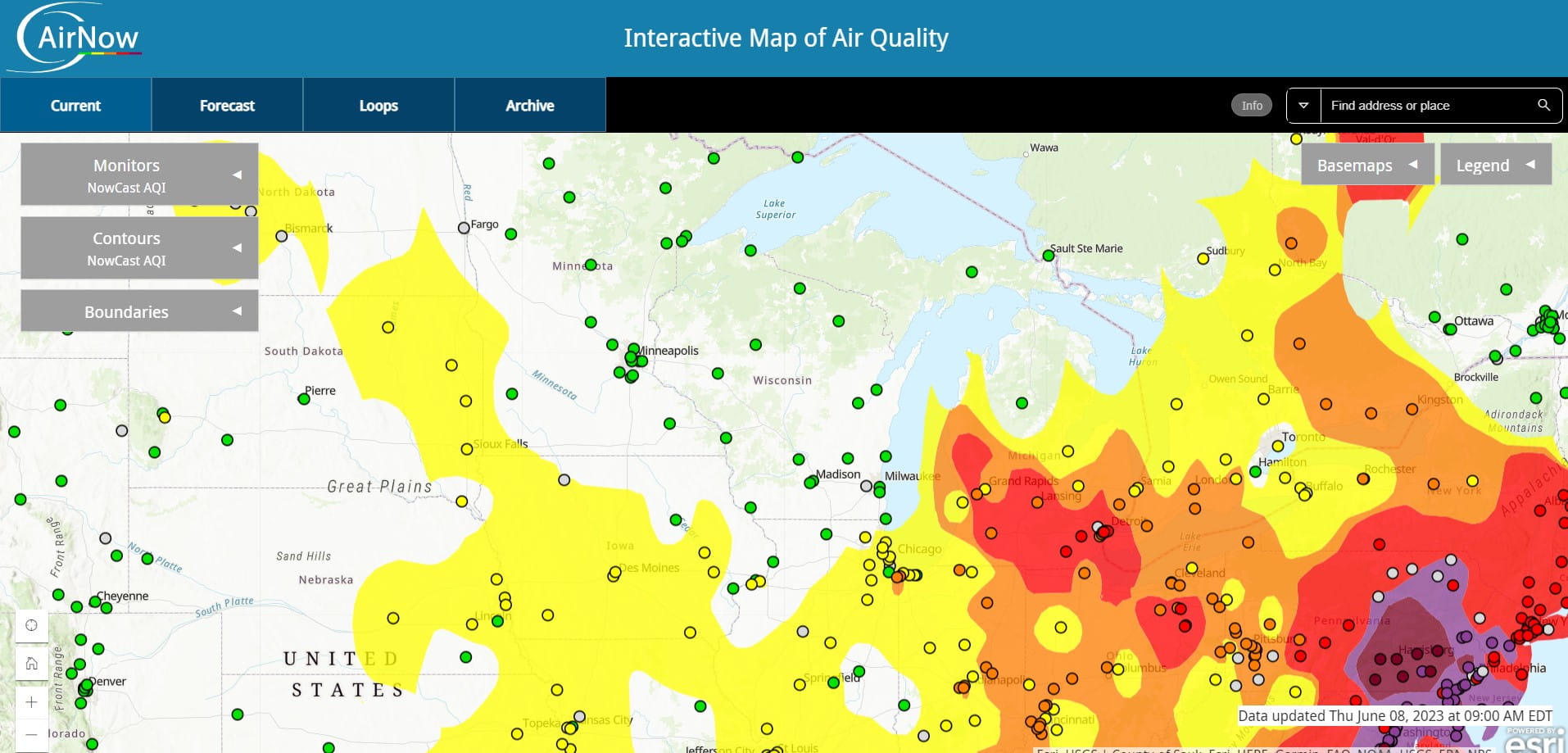The web Browser you are currently using is unsupported, and some features of this site may not work as intended. Please update to a modern browser such as Chrome, Firefox or Edge to experience all features Michigan.gov has to offer.
Wildfire smoke in Michigan resulted in several ‘firsts,’ EGLE offers air quality resources for Michigan
June 14, 2023
Smoke from the Canadian wildfires last week resulted in two “firsts” in Michigan:
- The first Action Day advisory for any pollutant in the U.P.
- The first Action Day advisories for fine particulates anywhere in the state. That covered most of the lower half of the Lower Peninsula.

Air Now map from June 8, 2023.
Unrelated to the wildfire smoke, Michigan also experienced its first Action Day advisory in the month of April for ozone.
The Michigan Department of Environment, Great Lakes, and Energy’s (EGLE) three meteorologists were busy fielding media calls, including the first live TV interview during prime time.
On EGLE’s social media channels, over 100,000 people saw the department’s posts on the Air Quality Action Day (33 times higher than EGLE’s average posts). Over 3,600 people engaged with EGLE posts (shared, commented, reacted, and clicked on posts).
Six direct social media inquiries were answered. EGLE posted and answered questions on Instagram, Twitter, and Facebook.
“By getting our message out, we were able to help protect public health and the environment, answer questions in real time, and prevent speculations and false information from spreading,” said Cheri Collard, EGLE’s social media strategist.
And while the air has cleared at the moment, extreme heat caused by climate change can cause longer and more severe dry periods due to increased evaporation and lack of rainfall, causing vegetation to ignite easier and fires to spread faster. Windy conditions, like we’ve seen, can not only help the fires to spread easier, but can also harm fire control efforts and cause severe air quality concerns not just locally, but even hundreds of miles away as the corresponding smoke is carried with the winds. As greenhouse gases continue to warm the planet, events like these will become all the more frequent and severe, highlighting the importance and necessity of near- and long-term climate action, and underscoring the need to rapidly implement the MI Healthy Climate Plan.
When smoke affected Michigan’s air quality, Michiganders flocked to resources for more information. EGLE and the Michigan Department of Health and Human Services (MDHHS) have a number of air quality resources available to the public.
How to sign up for alerts:
You can sign up for alerts through the EnviroFlash system. This subscriber system allows you to choose the area you would like to get alerts for. The system will send the alert directly to your email or send you a text message.
The Air Quality Index:
The Air Quality Index, or AQI is a color-coded way for residents to see what the levels of some types of air pollution are in their area. The higher the AQI, the worse the air quality is and the more cause for concern.
Currently the AQI for particulate matter (PM) is high in many parts of Michigan and the eastern US due to smoke and fires in the US and particularly in parts of Canada. The AQI is used for several major pollutants including ground-level ozone and particulates.
Protecting your health during smoke events:
The US Environmental Protection Agency (US EPA) has stated, “Most healthy adults and children will recover quickly from smoke exposure and will not have long-lasting health effects. But people with chronic diseases, such as asthma, other lung disease, or cardiovascular disease are at greater risk of experiencing more severe health effects. Children, pregnant people, and people over 65 also are more vulnerable to health effects from smoke exposure. Limit your outdoor exercise when it is smoky or choose lower-intensity activities to reduce your smoke exposure. When indoors, take steps to keep your indoor air cool and clean. For more tips, see When smoke is in the air.
MDHHS has advised the following:
For people with heart or lung disease, older adults, children, and teens it is suggested to take the following steps to reduce exposure:
- Avoid strenuous outdoor activities.
- Keep outdoor activities short.
- Consider moving physical activities indoors or rescheduling them.
For everyone else:
- Choose less strenuous activities (like walking instead of running) so you don’t breathe as hard.
- Shorten the amount of time you are active outdoors.
- Be active outdoors when air quality is better.
Follow MDHHS on social media for the most recent health and safety information:
- Michigan Department of Health and Human Services | Facebook
- Michigan HHS Dept (@MichiganHHS) / Twitter
Additional helpful resources:
These resources may be helpful to you if you are looking to learn more about air quality in your area, specifically around wildfires and smoke impacts.